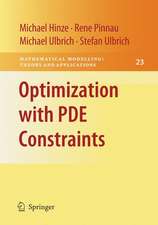Calculus of Variations II: Grundlehren der mathematischen Wissenschaften, cartea 311
Autor Mariano Giaquinta, Stefan Hildebrandten Limba Engleză Hardback – mar 1996
| Toate formatele și edițiile | Preț | Express |
|---|---|---|
| Paperback (1) | 799.44 lei 6-8 săpt. | |
| Springer Berlin, Heidelberg – 5 dec 2010 | 799.44 lei 6-8 săpt. | |
| Hardback (1) | 805.92 lei 6-8 săpt. | |
| Springer Berlin, Heidelberg – mar 1996 | 805.92 lei 6-8 săpt. |
Din seria Grundlehren der mathematischen Wissenschaften
-
 Preț: 353.84 lei
Preț: 353.84 lei - 24%
 Preț: 728.15 lei
Preț: 728.15 lei -
 Preț: 410.21 lei
Preț: 410.21 lei - 24%
 Preț: 587.87 lei
Preț: 587.87 lei - 17%
 Preț: 498.73 lei
Preț: 498.73 lei -
 Preț: 592.75 lei
Preț: 592.75 lei - 20%
 Preț: 692.49 lei
Preț: 692.49 lei - 24%
 Preț: 893.28 lei
Preț: 893.28 lei - 20%
 Preț: 824.73 lei
Preț: 824.73 lei - 24%
 Preț: 632.96 lei
Preț: 632.96 lei - 15%
 Preț: 596.69 lei
Preț: 596.69 lei - 15%
 Preț: 714.49 lei
Preț: 714.49 lei -
 Preț: 333.01 lei
Preț: 333.01 lei - 15%
 Preț: 473.16 lei
Preț: 473.16 lei -
 Preț: 356.49 lei
Preț: 356.49 lei -
 Preț: 484.43 lei
Preț: 484.43 lei - 15%
 Preț: 452.79 lei
Preț: 452.79 lei -
 Preț: 456.66 lei
Preț: 456.66 lei - 15%
 Preț: 708.75 lei
Preț: 708.75 lei -
 Preț: 423.08 lei
Preț: 423.08 lei - 15%
 Preț: 444.29 lei
Preț: 444.29 lei - 15%
 Preț: 527.79 lei
Preț: 527.79 lei - 15%
 Preț: 589.65 lei
Preț: 589.65 lei -
 Preț: 353.40 lei
Preț: 353.40 lei - 18%
 Preț: 727.66 lei
Preț: 727.66 lei -
 Preț: 387.96 lei
Preț: 387.96 lei - 15%
 Preț: 454.74 lei
Preț: 454.74 lei - 15%
 Preț: 481.03 lei
Preț: 481.03 lei -
 Preț: 464.55 lei
Preț: 464.55 lei -
 Preț: 348.77 lei
Preț: 348.77 lei -
 Preț: 362.04 lei
Preț: 362.04 lei -
 Preț: 488.12 lei
Preț: 488.12 lei - 15%
 Preț: 447.57 lei
Preț: 447.57 lei -
 Preț: 419.81 lei
Preț: 419.81 lei -
 Preț: 388.52 lei
Preț: 388.52 lei -
 Preț: 419.21 lei
Preț: 419.21 lei - 15%
 Preț: 581.01 lei
Preț: 581.01 lei -
 Preț: 497.75 lei
Preț: 497.75 lei -
 Preț: 360.53 lei
Preț: 360.53 lei -
 Preț: 387.75 lei
Preț: 387.75 lei -
 Preț: 419.81 lei
Preț: 419.81 lei - 18%
 Preț: 725.75 lei
Preț: 725.75 lei -
 Preț: 453.78 lei
Preț: 453.78 lei -
 Preț: 386.39 lei
Preț: 386.39 lei
Preț: 805.92 lei
Preț vechi: 982.82 lei
-18% Nou
Puncte Express: 1209
Preț estimativ în valută:
154.21€ • 160.69$ • 127.69£
154.21€ • 160.69$ • 127.69£
Carte tipărită la comandă
Livrare economică 03-17 aprilie
Preluare comenzi: 021 569.72.76
Specificații
ISBN-13: 9783540579618
ISBN-10: 3540579613
Pagini: 688
Ilustrații: XXIX, 655 p.
Dimensiuni: 155 x 235 x 41 mm
Greutate: 1.13 kg
Ediția:1996
Editura: Springer Berlin, Heidelberg
Colecția Springer
Seria Grundlehren der mathematischen Wissenschaften
Locul publicării:Berlin, Heidelberg, Germany
ISBN-10: 3540579613
Pagini: 688
Ilustrații: XXIX, 655 p.
Dimensiuni: 155 x 235 x 41 mm
Greutate: 1.13 kg
Ediția:1996
Editura: Springer Berlin, Heidelberg
Colecția Springer
Seria Grundlehren der mathematischen Wissenschaften
Locul publicării:Berlin, Heidelberg, Germany
Public țintă
ResearchCuprins
CALCULUS OF VARIATIONS I - The Lagrangian Formalism: Part I: The First Variation and Necessary Conditions: The First Variation; Variational Problems with Subsidiary Conditions; General Variational Formulas.- Part II: The Second Variation and Sufficient Conditions; Second Variation, Excess Function, Convexity; Weak Minimizers and Jacobi Theory; Weierstrass Field Theory for One-dimensional Integrals and Strong Minimizers. CALCULUS OF VARIATIONS II - The Hamiltonian Formalism: Part III: Canonical Formalism and Hamilton-Jacobi Theory; Legendre Transformation, Hamiltonian Systems, Convexity, Field Theories; Parametric Variational Integrals.- Part IV: Hamilton-Jacobi Theory and Canonical Transformations: Hamilton-Jacobi Theory and Canonical Transformations; Partial Differential Equations of First Order and Contact Transformations.
Textul de pe ultima copertă
This long-awaited book by two of the foremost researchers and writers in the field is the first part of a treatise that covers the subject in breadth and depth, paying special attention to the historical origins, partly in applications, e.g. from geometrical optics, of parts of the theory. A variety of aids to the reader are provided: besides the very detailed table of contents, an introduction to each chapter, section and subsection, an overview of the relevant literature (in Vol. 2) plus the references in the Scholia to each chapter, in the (historical) footnotes, and in the bibliography, and finally an index of the examples used throughout the book. Both individually and collectively these volumes have already become standard references.













